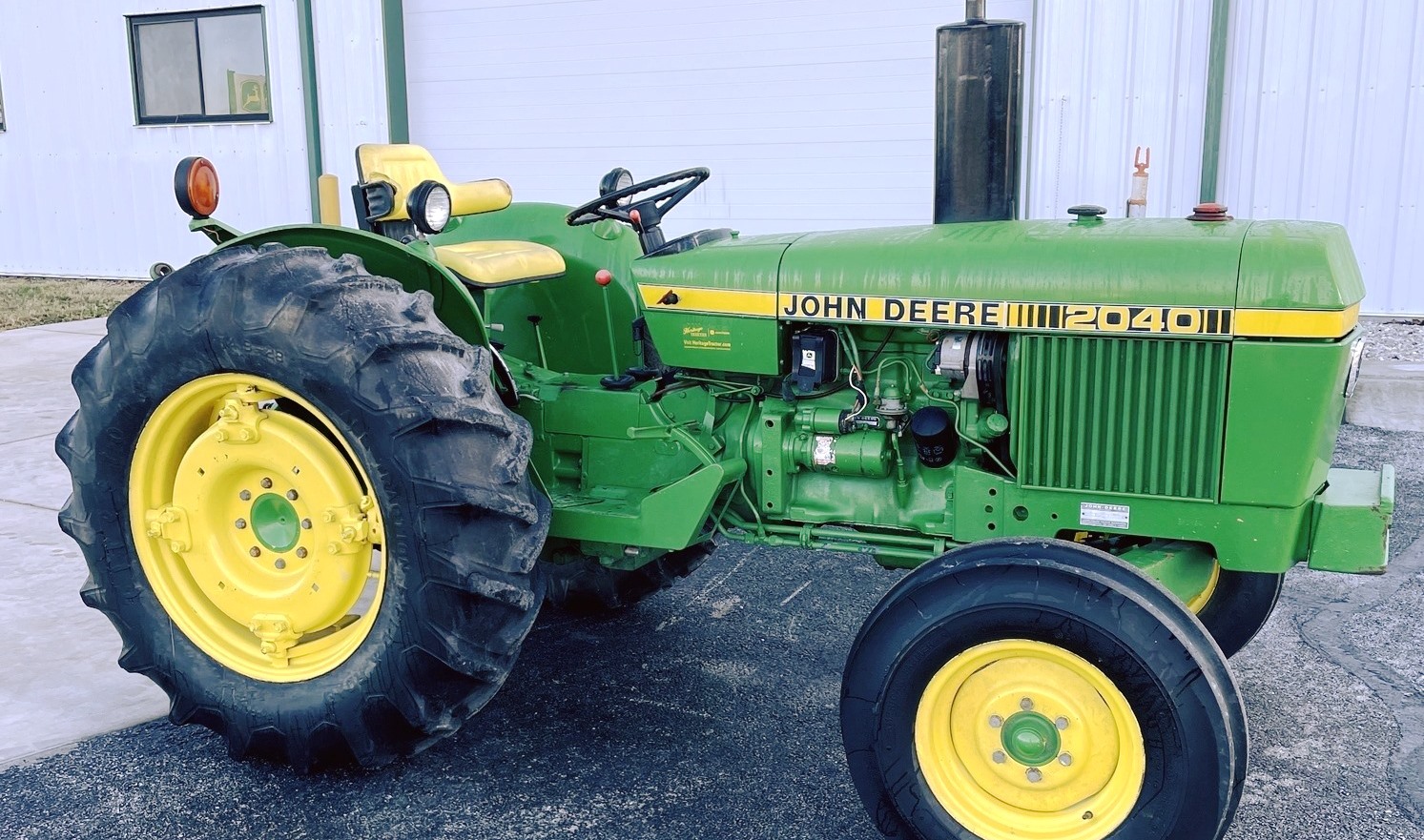The John Deere 2040, a utility tractor produced between 1976 and 1979 as part of the 2040 Series, holds a special place in agricultural history. Manufactured in Mannheim, Baden-Württemberg, Germany, it boasted a robust 3-cylinder diesel engine with a displacement of 2.7 liters and a compression ratio of 16.7:1. Known for its reliability and power, the 2040 had a 40 horsepower engine and a collar shift transmission offering 8 forward and 4 reverse gears. Its mechanical features included planetary final drives, a mechanical rear differential lock, and power steering. The tractor was equipped with hydraulic wet disc brakes and a two-post Roll-Gard ROPS cab for operator safety. With a variety of tire options and dimensions to suit different needs, the John Deere 2040 remains a symbol of efficiency and durability in the world of utility tractors, leaving a lasting legacy in agricultural equipment history.
| John Deere 2040 specs: |
|---|
| Model Year | 1976-1979 |
| Series | 2040 Series |
| Type | Utility tractor |
| Production |
|---|
| Manufacturer | John Deere |
| Type | Utility tractor |
| Factory | Mannheim, Baden-Württemberg, Germany |
| Power |
|---|
| PTO (claimed) | 40 hp (29.8 kW) |
| Drawbar (tested) | 32.87 hp (24.5 kW) |
| PTO (tested) | 40.86 hp (30.5 kW) |
| Engine Detail |
|---|
| Make | John Deere |
| Fuel | Diesel |
| Cylinders | 3-cylinder |
| Cooling | Liquid-cooled |
| Displacement | 164.4 cubic inches (2.7 liters) |
| Bore/Stroke | 4.016×4.331 inches (102 x 110 mm) |
| Compression Ratio | 16.7:1 |
| Rated RPM | 2500 |
| Operating RPM | 1500-2500 |
| Firing Order | 1-2-3 |
| Starter Volts | 12 |
| Coolant Capacity | 11.2 quarts (10.6 liters) |
| Transmission |
|---|
| Type | Collar shift |
| Gears | 8 forward and 4 reverse |
| Clutch | Dry 10-inch disc |
| Mechanical |
|---|
| Chassis | 4×2 2WD |
| Final Drives | Planetary |
| Differential Lock | Mechanical rear |
| Steering | Power |
| Brakes | Hydraulic wet disc |
| Cab | Two-post Roll-Gard ROPS |
| Hydraulics |
|---|
| Type | Open center / Closed center* |
| Valves | 1 |
| Tractor Hitch |
|---|
| Rear Type | I |
| Rear Lift (at 24″/610mm) | 2400 lbs (1088 kg) |
| Power Take-off (PTO) |
|---|
| Rear PTO | Live* |
| Clutch | Dry 9-inch disc |
| Rear RPM | 540 |
| Tires |
|---|
| Ag Front | 6.00-16 |
| Ag Rear | 13.6-28 |
| Dimensions |
|---|
| Wheelbase | 74.4 inches (188 cm) |
| Length | 131.25 inches (333 cm) |
| Width | 63 inches (160 cm *) / 89.6 inches (227 cm *) |
| Height (hood) | 52.6 inches (133 cm) |
| Weight | 4800 lbs (2177 kg) |
| Shipping Weight | 4060 lbs (1841 kg) |
| Ground Clearance | 13 inches (33 cm) |
| Front Tread | 49.5 to 79.5 inches (125 to 201 cm) |
| Rear Tread | 49.6 to 73 inches (125 to 185 cm) |
| Serial Numbers |
|---|
| 1976 | 179963 |
| 1977 | 221555 |
| 1978 | 266057 |
| 1979 | 304165 |
| 1980 | 350000 |
| 1981 | 392026 |
| 1982 | 419145 |
| Electrical |
|---|
| Ground | Negative |
| Charging System | Alternator |
| Battery Volts | 12 |
The John Deere 2040, a vintage utility tractor produced during the years 1976 to 1979, holds a special place in the world of collectible tractors due to its historical significance and distinct features. What makes it special is its durable construction and reliable performance, which have earned it a reputation as a workhorse in the agricultural industry. The tractor’s 40-horsepower engine, featuring a 3-cylinder liquid-cooled diesel, was known for its robustness and efficiency during its era.
One of the unique aspects of the John Deere 2040 is its German manufacturing origin, coming from the Mannheim factory in Baden-Württemberg. This sets it apart from many other John Deere models that were produced in the United States. Its compact size and versatile power output made it a versatile choice for a range of farming tasks, from plowing fields to operating various implements.
Advantages of the John Deere 2040 include its reliability, ease of maintenance, and compatibility with a variety of attachments and implements. Its power take-off (PTO) system and hydraulic capabilities made it adaptable to different farming needs. Additionally, its power steering and Roll-Gard ROPS cab provided comfort and safety for the operator.
Like many vintage tractors, the John Deere 2040 may have some disadvantages when compared to modern counterparts. Its older technology may result in lower fuel efficiency and emissions standards by today’s measures. Parts availability for maintenance and repairs may also be a challenge, although the tractor’s popularity among collectors has led to a thriving aftermarket for components.
Summarizing, the John Deere 2040 stands out as a collectible tractor with historical value due to its German manufacturing origin, durable construction, and reliable performance. While it may have some limitations compared to modern tractors, its enduring popularity among enthusiasts and its role in agricultural history make it a cherished piece in any tractor collection.
